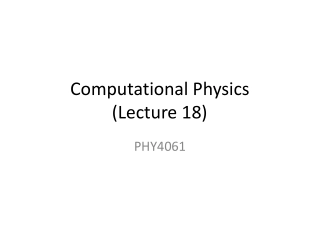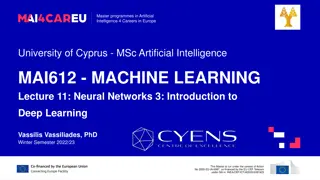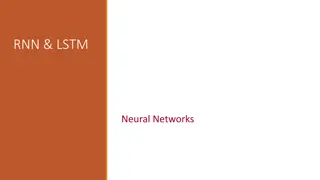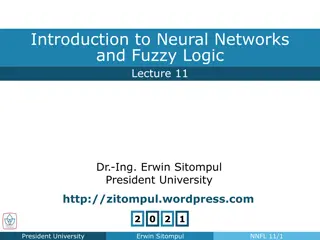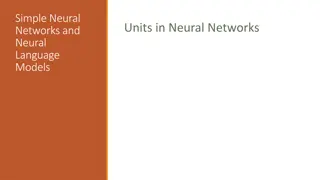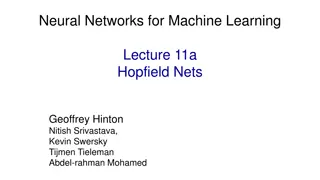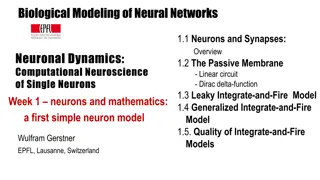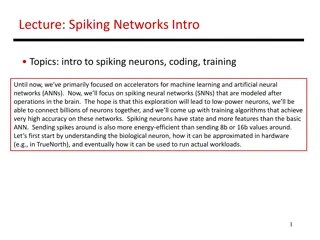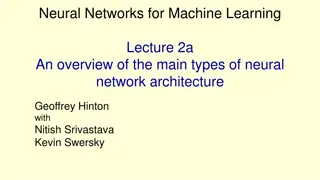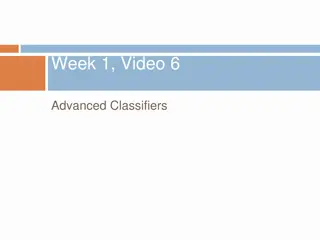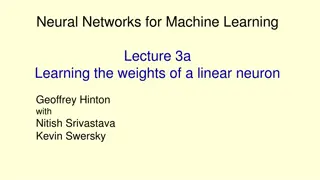Introduction to Perceptrons and Neurons in Neural Networks
This content provides an overview of perceptrons, their functionality in mapping D-dimensional vectors, and how they are inspired by neurons in the brain. It covers the computation process of perceptrons, including bias weight notation, activation functions, and the significance of different choices for activation functions.
Uploaded on Feb 23, 2025 | 2 Views
Download Presentation

Please find below an Image/Link to download the presentation.
The content on the website is provided AS IS for your information and personal use only. It may not be sold, licensed, or shared on other websites without obtaining consent from the author.If you encounter any issues during the download, it is possible that the publisher has removed the file from their server.
You are allowed to download the files provided on this website for personal or commercial use, subject to the condition that they are used lawfully. All files are the property of their respective owners.
The content on the website is provided AS IS for your information and personal use only. It may not be sold, licensed, or shared on other websites without obtaining consent from the author.
E N D
Presentation Transcript
Neural Networks Part 1 - Introduction CSE 4309 Machine Learning Vassilis Athitsos Computer Science and Engineering Department University of Texas at Arlington 1
1 Perceptrons ?1 Output: ? ? = ? + ??? ?2 ?? ?1 ?2 ?3 ?? A perceptron is a function that maps D-dimensional vectors to real numbers. For notational convenience, we add an extra input, called the bias input. The bias input is always equal to 1. ? is called the bias weight. It is optimized during training. ?1, ,?? are also weights that are optimized during training. ? = 2
1 Perceptrons ?1 Output: ? ? = ? + ??? ?2 ?? A perceptron computes its output ? in two steps: ? Step 1: ? = ? + ??? = ? + ?=0 ???? Step 2: ? = ? is called an activation function. 1 For example, could be the sigmoid function ? ? = 3 1+? ?
1 Perceptrons ?1 Output: ? ? = ? + ??? ?2 ?? A perceptron computes its output ? in two steps: ? Step 1: ? = ? + ??? = ? + ?=0 ???? Step 2: ? = ? ? In a single formula: ? = ? + ?=0 ???? 4
1 Notation for Bias Weight ?1 Output: ? ? = ??? ?2 ?? There is an alternative representation that we will not use, where ? is denoted as ?0, and weight vector ? = ?0,?1,?2, ,??. Then, instead of writing ? = ? + ??? we can simply write ? = ??? . In our slides, we will denote the bias weight as ? and treat it separately from the other weights. That will make life easier later. 5
1 Perceptrons and Neurons ?1 Output: ? ? = ? + ??? ?2 ?? Perceptrons are inspired by neurons. Neurons are the cells forming the nervous system, and the brain. Neurons somehow sum up their inputs, and if the sum exceeds a threshold, they "fire". Since brains are "intelligent", computer scientists have been hoping that perceptron-based systems can be used to model intelligence. 6
Activation Functions A perceptron produces output ? = ? + ??? . One choice for the activation function : the step function. ? = 0,if ? < 0 1,if ? 0 The step function is useful for providing some intuitive examples. It is not useful for actual real-world systems. Reason: it is not differentiable, it does not allow optimization via gradient descent. 7
Activation Functions A perceptron produces output ? = ? + ??? . Another choice for the activation function (?): the sigmoidal function. 1 ? ? = 1+? ? The sigmoidal is often used in real-world systems. It is a differentiable function, it allows use of gradient descent. 8
Example: The AND Perceptron Suppose we use the step function for activation. Suppose boolean value false is represented as number 0. Suppose boolean value true is represented as number 1. Then, the perceptron below computes the boolean AND function: false AND false = false false AND true = false true AND false = false true AND true = true 1 ?1 Output: ? ? = ? + ??? ?2 9
Example: The AND Perceptron Verification: If ?1= 0 and ?2= 0: ? + ??? = 1.5 + 1 0 + 1 0 = 1.5. ? + ??? = h 1.5 = 0. Corresponds to case false AND false = false. false AND false = false false AND true = false true AND false = false true AND true = true 1 ?1 Output: ? ? = ? + ??? ?2 10
Example: The AND Perceptron Verification: If ?1= 0 and ?2= 1: ? + ??? = 1.5 + 1 0 + 1 1 = 0.5. ? + ??? = h 0.5 = 0. Corresponds to case false AND true = false. false AND false = false false AND true = false true AND false = false true AND true = true 1 ?1 Output: ? ? = ? + ??? ?2 11
Example: The AND Perceptron Verification: If ?1= 1 and ?2= 0: ? + ??? = 1.5 + 1 1 + 1 0 = 0.5. ? + ??? = h 0.5 = 0. Corresponds to case true AND false = false. false AND false = false false AND true = false true AND false = false true AND true = true 1 ?1 Output: ? ? = ? + ??? ?2 12
Example: The AND Perceptron Verification: If ?1= 1 and ?2= 1: ? + ??? = 1.5 + 1 1 + 1 1 = 0.5. ? + ??? = h 0.5 = 1. Corresponds to case true AND true = true. false AND false = false false AND true = false true AND false = false true AND true = true 1 ?1 Output: ? ? = ? + ??? ?2 13
Example: The OR Perceptron Suppose we use the step function for activation. Suppose boolean value false is represented as number 0. Suppose boolean value true is represented as number 1. Then, the perceptron below computes the boolean OR function: false OR false = false false OR true = true true OR false = true true OR true = true 1 ?1 Output: ? ? = ? + ??? ?2 14
Example: The OR Perceptron Verification: If ?1= 0 and ?2= 0: ? + ??? = 0.5 + 1 0 + 1 0 = 0.5. ? + ??? = h 0.5 = 0. Corresponds to case false OR false = false. false OR false = false false OR true = true true OR false = true true OR true = true 1 ?1 Output: ? ? = ? + ??? ?2 15
Example: The OR Perceptron Verification: If ?1= 0 and ?2= 1: ? + ??? = 0.5 + 1 0 + 1 1 = 0.5. ? + ??? = h 0.5 = 1. Corresponds to case false OR true = true. false OR false = false false OR true = true true OR false = true true OR true = true 1 ?1 Output: ? ? = ? + ??? ?2 16
Example: The OR Perceptron Verification: If ?1= 1 and ?2= 0: ? + ??? = 0.5 + 1 1 + 1 0 = 0.5. ? + ??? = h 0.5 = 1. Corresponds to case true OR false = true. false OR false = false false OR true = true true OR false = true true OR true = true 1 ?1 Output: ? ? = ? + ??? ?2 17
Example: The OR Perceptron Verification: If ?1= 1 and ?2= 1: ? + ??? = 0.5 + 1 1 + 1 1 = 1.5. ? + ??? = h 1.5 = 1. Corresponds to case true OR true = true. false OR false = false false OR true = true true OR false = true true OR true = true 1 ?1 Output: ? ? = ? + ??? ?2 18
Example: The NOT Perceptron Suppose we use the step function for activation. Suppose boolean value false is represented as number 0. Suppose boolean value true is represented as number 1. Then, the perceptron below computes the boolean NOT function: NOT(false) = true NOT(true) = false 1 Output: ? ?1= 1 ? = ? + ??? ?1 19
Example: The NOT Perceptron Verification: If ?1= 0: ? + ??? = 0.5 1 0 = 0.5. ? + ??? = h 0.5 = 1. Corresponds to case NOT(false) = true. NOT(false) = true NOT(true) = false 1 Output: ? ?1= 1 ? = ? + ??? ?1 20
Example: The NOT Perceptron Verification: If ?1= 1: ? + ??? = 0.5 1 1 = 0.5. ? + ??? = h 0.5 = 0. Corresponds to case NOT(true) = false. NOT(false) = true NOT(true) = false 1 Output: ? ?1= 1 ? = ? + ??? ?1 21
The XOR Function false XOR false = false false XOR true = true true XOR false = true true XOR true = false As before, we represent false with 0 and true with 1. The figure shows the four input points of the XOR function. red corresponds to output value true. green corresponds to output value false. The two classes (true and false) are not linearly separable. Therefore, no perceptron can compute the XOR function. 22
Our First Neural Network: XOR A neural network is built using perceptrons as building blocks. The inputs to some perceptrons are outputs of other perceptrons. Here is an example neural network computing the XOR function. Input unit, outputs ?1 Unit 2,1 Unit 1,1 Output: Unit 3,1 Unit 1,2 Unit 2,2 Input unit, outputs ?2 23
Our First Neural Network: XOR Terminology: inputs and perceptrons are all called units . Units are grouped in layers: layer 1 (input), layer 2, layer 3 (output). The input layer just represents the inputs to the network. There are two inputs: ?1 and ?2. Input unit, outputs ?1 Unit 2,1 Unit 1,1 Output: Unit 3,1 Unit 1,2 Unit 2,2 Input unit, outputs ?2 24 24
Our First Neural Network: XOR Such networks are called layered networks, more details later. Each unit is indexed by two numbers (layer index, unit index). Each bias weight ? is indexed by the same two numbers as its unit. Each weight ? is indexed by three numbers (layer, unit, weight). Input unit, outputs ?1 Unit 2,1 Unit 1,1 Output: Unit 3,1 Unit 1,2 Unit 2,2 Input unit, outputs ?2 25 25
Our First Neural Network: XOR Note: every weight is associated with two units: it connects the output of a unit with an input of another unit. Which of the two units do we use to index the weight? Input unit, outputs ?1 Unit 2,1 Unit 1,1 Output: Unit 3,1 Unit 1,2 Unit 2,2 Input unit, outputs ?2 26 26
Our First Neural Network: XOR To index a weight ?, we use the layer number and unit number of the unit for which ? is an incoming weight. Weights incoming to unit ?,? are indexed as ?,?,?, where ? ranges from 1 to the number of incoming weights for unit ?,?. Input unit, outputs ?1 Unit 2,1 Unit 1,1 Output: Unit 3,1 Unit 1,2 Unit 2,2 Input unit, outputs ?2 27 27
Our First Neural Network: XOR Weights incoming to unit ?,? are indexed as ?,?,?, where ? ranges from 1 to the number of incoming weights for unit ?,?. Since the input layer (which is layer 1) has no incoming weights, there are no weights indexed as ?1,?,?. Input unit, outputs ?1 Unit 2,1 Unit 1,1 Output: Unit 3,1 Unit 1,2 Unit 2,2 Input unit, outputs ?2 28 28
Our First Neural Network: XOR The XOR network shows how individual perceptrons can be combined to perform more complicated functions. Logical OR Input unit, outputs ?1 Logical (A AND (NOT B) Unit 2,1 Unit 1,1 Output: Unit 3,1 Logical AND Unit 1,2 Unit 2,2 Input unit, outputs ?2 29
Computing the Output: An Example Suppose that ?1= 0,?2= 1 (corresponding to false XOR true). For Unit 2,1, which performs a logical OR: The output is 0.5 + 0 1 + 1 1 = 0.5 . Assuming that is the step function, 0.5 = 1, so Unit 2,1 outputs 1. Input unit, outputs 0 Unit 2,1 (OR) Unit 1,1 Unit 3,1 (A AND (NOT B)) Output: Unit 1,2 Unit 2,2 (AND) Input unit, outputs 1 30
Computing the Output: An Example Suppose that ?1= 0,?2= 1 (corresponding to false XOR true). For Unit 2,2, which performs a logical AND: The output is 1.5 + 0 1 + 1 1 = 0.5 . Since is the step function, 0.5 = 0, so Unit 2,2 outputs 0. Input unit, outputs 0 Unit 2,1 (OR) Unit 1,1 Unit 3,1 (A AND (NOT B)) Output: Unit 1,2 Unit 2,2 (AND) Input unit, outputs 1 31
Computing the Output: An Example Suppose that ?1= 0,?2=1 (corresponding to false XOR true). Unit 3,1 is the output unit, computing the A AND (NOT B) function: One input is the output of the OR unit, which is 1. The other input is the output of the AND unit, which is 0. Input unit, outputs 0 Unit 2,1 (OR) Unit 1,1 Unit 3,1 (A AND (NOT B)) Output: Unit 1,2 Unit 2,2 (AND) Input unit, outputs 1 32
Computing the Output: An Example Suppose that ?1= 0,?2=1 (corresponding to false XOR true). For the output unit (computing the A AND (NOT B) function): The output is 0.5 + 1 1 + 0 ( 1) = 0.5 . Since is the step function, 0.5 = 0, so Unit 3,1 outputs 1. Input unit, outputs 0 Unit 2,1 (OR) Unit 1,1 Unit 3,1 (A AND (NOT B)) Output: 1 Unit 1,2 Unit 2,2 (AND) Input unit, outputs 1 33
Verifying the XOR Network We can follow the same process to compute the output of this network for the other three cases. Here we consider the case where ?1= 0,?2= 0 (corresponding to false XOR false). The output is 0, as it should be. Input unit, outputs 0 Unit 2,1 (OR) Unit 1,1 Unit 3,1 (A AND (NOT B)) Output: 0 Unit 1,2 Unit 2,2 (AND) Input unit, outputs 0 34
Verifying the XOR Network We can follow the same process to compute the output of this network for the other three cases. Here we consider the case where ?1= 1,?2= 0 (corresponding to true XOR false). The output is 1, as it should be. Input unit, outputs 1 Unit 2,1 (OR) Unit 1,1 Unit 3,1 (A AND (NOT B)) Output: 1 Unit 1,2 Unit 2,2 (AND) Input unit, outputs 0 35
Verifying the XOR Network We can follow the same process to compute the output of this network for the other three cases. Here we consider the case where ?1= 1,?2= 1 (corresponding to true XOR true). The output is 0, as it should be. Input unit, outputs 1 Unit 2,1 (OR) Unit 1,1 Unit 3,1 (A AND (NOT B)) Output: 0 Unit 1,2 Unit 2,2 (AND) Input unit, outputs 1 36
Neural Networks Our XOR neural network consists of five units: Two input units, that just represent the two inputs to the network. Three perceptrons. Input unit, outputs ?1 Unit 2,1 Unit 1,1 Output: Unit 3,1 Unit 1,2 Unit 2,2 Input unit, outputs ?2 37
Neural Network Layers Oftentimes, as in the XOR example, neural networks are organized into layers. The input layer is the initial layer of input units (units 1,1 and 1,2 in our example). The output layer is at the end (unit 3,1 in our example). Zero, one or more hidden layers can be between the input and output layers. Input unit, outputs ?1 Unit 2,1 Unit 1,1 Output: Unit 3,1 Unit 1,2 Unit 2,2 Input unit, outputs ?2 38
Neural Network Layers There is only one hidden layer in our example, containing units 2,1 and 2,2. Each hidden layer's inputs are outputs from the previous layer. Each hidden layer's outputs are inputs to the next layer. The first hidden layer's inputs come from the input layer. The last hidden layer's outputs are inputs to the output layer. Input unit, outputs ?1 Unit 2,1 Unit 1,1 Output: Unit 3,1 Unit 1,2 Unit 2,2 Input unit, outputs ?2 39
Feedforward Networks Feedforward networks are networks where there are no directed loops. If there are no loops, the output of a unit cannot (directly or indirectly) influence its input. While there are varieties of neural networks that are not feedforward or layered, our main focus will be layered feedforward networks. Input unit, outputs ?1 Unit 2,1 Unit 1,1 Output: Unit 3,1 Unit 1,2 Unit 2,2 Input unit, outputs ?2 40
Computing the Output Notation: ? is the number of layers. Layer 1 is the input layer, layer ? is the output layer. The outputs of the units of layer 1 are simply the inputs to the network. For (layer ? = 2;? ?;? = ? + 1): Compute the outputs of layer ?, given the outputs of layer ? 1. Input unit, outputs ?1 Unit 2,1 Unit 1,1 Output: Unit 3,1 Unit 1,2 Unit 2,2 Input unit, outputs ?2 41
Computing the Output To compute the outputs of layer ? (where ? > 1), we simply need to compute the output of each perceptron belonging to layer ? . For each such perceptron, its inputs are coming from outputs of units at layer ? 1, which we have already computed. Remember, we compute layer outputs in increasing order of ?. Input unit, outputs ?1 Unit 2,1 Unit 1,1 Output: Unit 3,1 Unit 1,2 Unit 2,2 Input unit, outputs ?2 42
What Neural Networks Can Compute An individual perceptron is a linear classifier. The weights of the perceptron define a linear boundary between two classes. Layered feedforward neural networks with one hidden layer can compute any continuous function. Layered feedforward neural networks with two hidden layers can compute any mathematical function. This has been known for decades, and is one reason scientists have been optimistic about the potential of neural networks to model intelligent systems. Another reason is the analogy between neural networks and biological brains, which have been a standard of intelligence we are still trying to achieve. There is only one catch: How do we find the right model? 43
Finding the Right Model Finding the right model means that we need to determine: The number of layers. The number of units for each layer. The way that layers are connected to each other. The activation functions to use. Values for all weights (bias and regular weights) Unfortunately, when training a neural network, the items in red must be specified as hyperparameters. Quite a bit of trial-and-error is needed to identify good choices. Backpropagation, which is the standard algorithm for training a neural network, focuses exclusively on finding good values for the weights in the network. Even that can be a challenging task, due to local minima. 44
Recap Neural networks are powerful computational models. They can compute any mathematical function. Thus, if there exists a mathematical function that works really well for our problem, that means that there exists a neural network that works really well for our problem. The key challenge is to find the right model for a given problem. Network topology (number of layers, units per layer, connectivity among layers) must be specified by hand. Backpropagation may get stuck in local minima, even if there is a much better solution for the weights. Still, in practice, neural networks are really useful in many real-world applications, and they are important tools used widely in industry. 45


